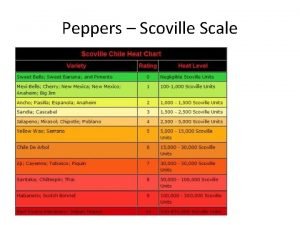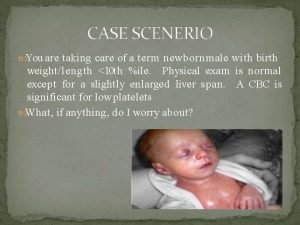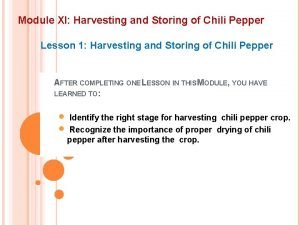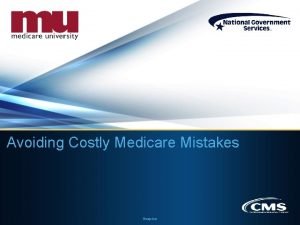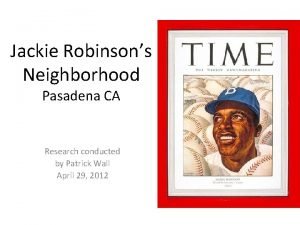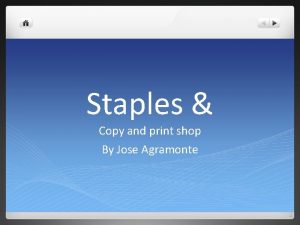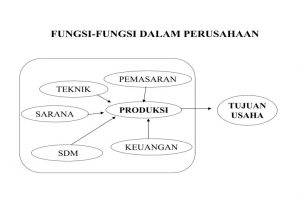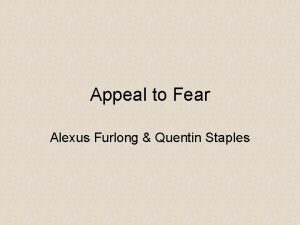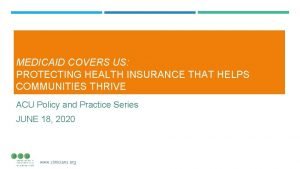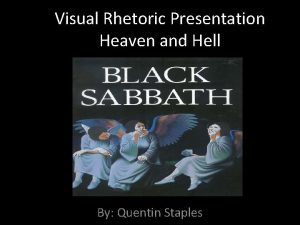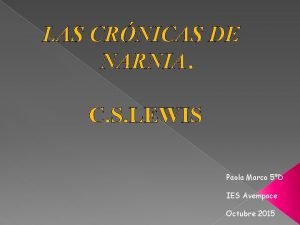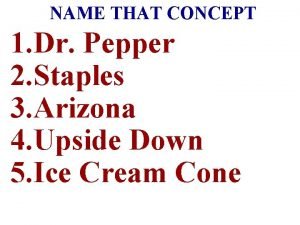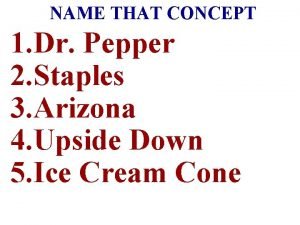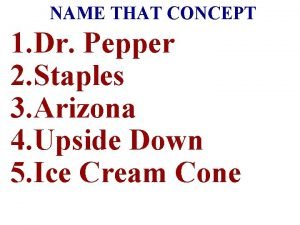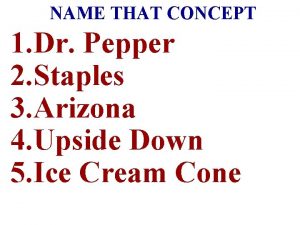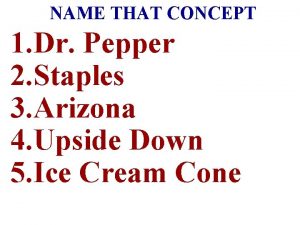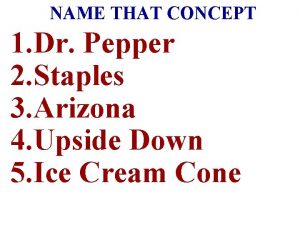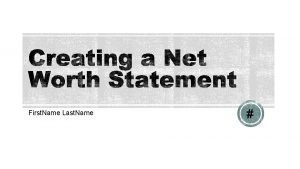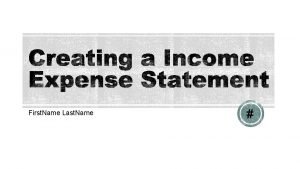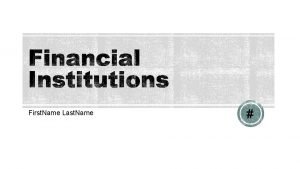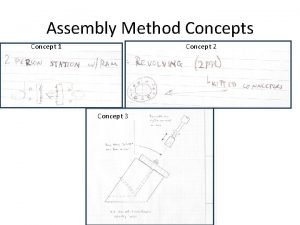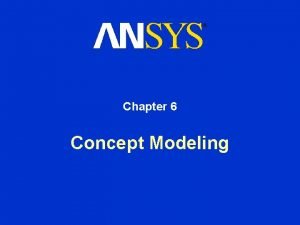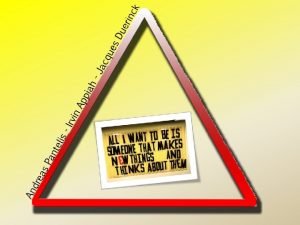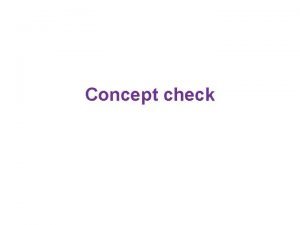NAME THAT CONCEPT 1 Dr Pepper 2 Staples










































- Slides: 42

NAME THAT CONCEPT 1. Dr. Pepper 2. Staples 3. Arizona 4. Upside Down 5. Ice Cream Cone

NAME THAT CONCEPT 1. Fish 2. Sharp 3. Frozen 4. Church 5. Diet

NAME THAT CONCEPT 1. Macroeconomics 2. Inflation 3. Nominal GDP 4. Structural Unemp. 5. C+I+G+Xn

NAME THAT CONCEPT 1. REAL GDP 2. FULL EMPLOYM. 3. CYCLICAL UNEMP. 4. BASE YEAR 5. FRICTIONAL UNEMPLOYMENT

Goal #3 LIMIT INFLATION Country and Time- Zimbabwe, 2008 Annual Inflation Rate 79, 600, 000% Time for Prices to Double 24. 7 hours

What is Inflation? Inflation is rising general level of prices Inflation reduces the “purchasing power” of money Examples: • It takes $2 to buy what $1 bought in 1982 • It takes $6 to buy what $1 bought in 1961 • When inflation occurs, each dollar of income will buy fewer goods than before.

How is Inflation measured? The government tracks the prices of the same goods and services each year. • This “market basket” is made up of about 300 commonly purchased goods • The Inflation Rate-% change in prices in 1 year • They also compare changes in prices to a given base year (usually 1982) • Prices of subsequent years are then expressed as a percentage of the base year • Examples: • 2005 inflation rate was 3. 4% • U. S. prices have increase 98. 3% since 1982 (base year). • The inflation rate in Bolivia in 1985 was 50, 000% • This is called Hyperinflation • A $25 meal today would cost $12, 525 a year later

World Inflation Rates

Historic Inflation Rates


Current Data

Is Inflation Good or Bad?

Identify which people are helped and which are hurt by unanticipated inflation? 1. A man who lent out $500 to his friend in 1960 and is still waiting to be paid back. 2. A tenant who is charged $850 rent each year. 3. An elderly couple living off fixed retirement payments of $2000 a month 4. A man that borrowed $1, 000 in 1995 and paid it back in 2006 5. A women who saved a paycheck from 1950 by putting it under her mattress

Make a T-Chart Hurt by Inflation Helped by Inflation • Lenders-People who • Borrowers-People lend money (at fixed who borrow money interest rates) • A business where the • People with fixed price of the product incomes increases faster than • Savers the price of resources Cost-of-Living-Adjustment (COLA) Some works have salaries that mirror inflation. They negotiated wages that rise with inflation

Measuring Inflation Consumer Price Index (CPI)

Consumer Price Index (CPI) The most commonly used measurement inflation for consumers is the Consumer Price Index Here is how it works: • The base year is given an index of 100 • To compare, each year is given an index # as well CPI = Price of market basket in base year x 100 1997 Market Basket: Movie is $6 & Pizza is $14 Total = $20 (Index of Base Year = 100) 2009 Market Basket: Movie is $8 & Pizza is $17 125 Total = $25 (Index of ) • This means inflation increased 25% b/w ’ 97 & ‘ 09 • Items that cost $100 in ’ 97 cost $125 in ‘ 09


Problems with the CPI 1. Substitution Bias- As prices increase for the fixed market basket, consumers buy less of these products and more substitutes that may not be part of the market basket. (Result: CPI may be higher than what consumers are really paying) 2. New Products- The CPI market basket may not include the newest consumer products. (Result: CPI measures prices but not the increase in choices) 3. Product Quality- The CPI ignores both improvements and decline in product quality. (Result: CPI may suggest that prices stay the same though the economic well being has improved significantly)

Calculating Nominal GDP, Real GDP, and Inflation

Calculating CPI Year 1 2 3 4 5 Nominal, Units of Price GDP Output Per Unit 10 10 15 20 25 Real, GDP CPI/ GDP Deflator (Year 1 as Base Year) $ 4 5 6 8 4 Make year one the base year CPI= Price of market basket in the particular year x 100 Price of the same market basket in base year Inflation Rate

Calculating CPI Year 1 2 3 4 5 Nominal, Units of Price GDP Output Per Unit 10 10 15 20 25 $40 50 90 160 100 $ 4 5 6 8 4 Real, GDP CPI/ GDP Deflator (Year 1 as Base Year) $40 40 60 80 100 125 150 200 100 Inflation Rate N/A 25% 20% 33. 33% -50% Inflation Rate % Change in Prices = Year 2 - Year 1 X 100

Practice Year 1 2 3 4 5 Nominal, Units of Price GDP Output Per Unit 5 10 20 40 50 $ 6 8 10 12 14 $30 80 200 480 700 Real, GDP $50 100 200 400 500 Consumer Price Index (Year 3 as Base Year) 60 80 100 120 140 Make year three the base year CPI = Price of market basket in the particular year Price of the same market basket in base year x 100

CPI vs. GDP Deflator The GDP deflator measures the prices of all goods produced, whereas the CPI measures prices of only the goods and services bought by consumers. An increase in the price of goods bought by firms or the government will show up in the GDP deflator but not in the CPI. The GDP deflator includes only those goods and services produced domestically. Imported goods are not a part of GDP and therefore don’t show up in the GDP deflator. GDP Deflator = Nominal GDP Real GDP x 100 If the nominal GDP in ’ 09 was 25 and the real GDP (compared to a base year) was 20 how much is the GDP Deflator?

Calculating GDP Deflator Nominal GDP = = Nominal GDP Real GDP x 100 (Deflator) x (Real GDP) 100

Calculations 1. In an economy, Real GDP (base year = 1996) is $100 billion and the Nominal GDP is $150 billion. Calculate the GDP deflator. 2. In an economy, Real GDP (base year = 1996) is $125 billion and the Nominal GDP is $150 billion. Calculate the GDP deflator. 3. In an economy, Real GDP for year 2002 (base year = 1996) is $200 billion and the GDP deflator 2002 (base year = 1996) is 120. Calculate the Nominal GDP for 2002. 4. In an economy, Nominal GDP for year 2005 (base year = 1996) is $60 billion and the GDP deflator 2005 (base year = 1996) is 120. Calculate the Real GDP for 2005.



1. 2. 3. 4. 5. Review Identify the 3 goals of all economies Define Natural Rate of Unemployment Define inflation rate What is a market basket? Explain the difference between nominal and real interest rates 6. How do you calculate CPI? 7. What does a CPI of 130 mean? 8. Who is helped and hurt by inflation? 9. Why did Bolivia experience hyperinflation? 10. List 10 old-school Nintendo games

Three Causes of Inflation 1. If everyone suddenly had a million dollars, what would happen? 2. What two things cause prices to increase? Use Supply and Demand

3 Causes of Inflation 1. The Government Prints TOO MUCH Money (The Quantity Theory) • Governments that keep printing money to pay debts end up with hyperinflation. • There are more “rich” people but the same amount of products. • Result: Banks refuse to lend and GDP falls Examples: • Bolivia, Peru, Brazil • Germany after WWI

Quantity Theory of Money If the real GDP in a year is $400 billion but the amount of money in the economy is only $100 billion, how are we paying for things? The velocity of money is the average times a dollar is spent and re-spent in a year. How much is the velocity of money in the above example? Quanity Theory of Money Equation: M x V = P x Y M = money supply V = velocity P = price level Y = quantity of output Notice that P x Y is GDP 31

M x V = P x Y Why does printing money lead to inflation? • Assume the velocity is relatively constant because people's spending habits are not quick to change. • Also assume that output (Y) is not affected by the amount of money because it is based on production, not the value of the stuff produced. If the govenment increases the amount of money (M) what will happen to prices (P)? Ex: Assume money supply is $5 and it is being used to buy 10 products with a price of $2 each. 1. How much is the velocity of money? 2. If the velocity and output stay the same, what will happen if the amount of money is increase to $10? Notice, doubling the money supply doubles prices 32

What would happen if the government printed money to pay off the national debt all at once?

3 Causes of Inflation 2. DEMAND-PULL INFLATION “Too many dollars chasing too few goods” DEMAND PULLS UP PRICES!!! • Demand increases but supply stays the same. What is the result? • A Shortage driving prices up • An overheated economy with excessive spending but same amount of goods.

3 Causes of Inflation 3. COST-PUSH INFLATION Higher production costs increase prices A negative supply shock increases the costs of production and forces producers to increase prices. Examples: • Hurricane Katrina destroyed oil refineries and causes gas prices to go up. Companies that use gas increase their prices.

Cost-Push Inflation

The Wage-Price Spiral A Perpetual Process: 1. Workers demand raises 2. Owners increase prices to pay for raises 3. High prices cause workers to demand higher raises 4. Owners increase prices to pay for higher raises 5. High prices cause workers to demand higher raises 6. Owners increase prices to pay for higher raises

Cartoon Video: Why Play Leap Frog? 38

Interest Rates 39

Interest Rates and Inflation What are interest rates? Why do lenders charge them? Who is willing to lend me $100 if I will pay a total interest rate of 100%? (I plan to pay you back in 2050) If the nominal interest rate is 10% and the inflation rate is 15%, how much is the REAL interest rate? Real Interest Rates. The percentage increase in purchasing power that a borrower pays. (adjusted for inflation) Real = nominal interest rate - expected inflation Nominal Interest Rates- the percentage increase in money that the borrower pays not adjusting for inflation. Nominal = Real interest rate + expected inflation

Nominal vs. Real Interest Rates Example #1: You lend out $100 with 20% interest. Inflation is 15%. A year later you get paid back $120. What is the nominal and what is the real interest rate? Nominal interest rate is 20%. Real interest rate was 5% In reality, you get paid back an amount with more purchasing power. Example #2: You lend out $100 with 10% interest. Prices are expected to increased 20%. In a year you get paid back $110. What is the nominal and what is the real interest rate? Nominal interest rate is 10%. Real rate was – 10% In reality, you get paid back an amount with less purchasing power.

Achieving the Three Goals The governments role is to prevent unemployment and prevent inflation at the same time. • If the government focuses too much on preventing inflation and slows down the economy we will have unemployment. • If the government focuses too much on limiting unemployment and overheats the economy we will have inflation Unemployment Inflation GDP Growth Good 6% or less 1%-4% 2. 5%-5% Worry 6. 5%-8% 1%-2% Bad 8. 5 % or more 9% or more . 5% or less
 Phân độ lown
Phân độ lown Block xoang nhĩ là gì
Block xoang nhĩ là gì Thơ thất ngôn tứ tuyệt đường luật
Thơ thất ngôn tứ tuyệt đường luật Thơ thất ngôn tứ tuyệt đường luật
Thơ thất ngôn tứ tuyệt đường luật Walmart thất bại ở nhật
Walmart thất bại ở nhật Tìm vết của mặt phẳng
Tìm vết của mặt phẳng Con hãy đưa tay khi thấy người vấp ngã
Con hãy đưa tay khi thấy người vấp ngã Tôn thất thuyết là ai
Tôn thất thuyết là ai Gây tê cơ vuông thắt lưng
Gây tê cơ vuông thắt lưng Sau thất bại ở hồ điển triệt
Sau thất bại ở hồ điển triệt Name all the lines name all the segments name all the rays
Name all the lines name all the segments name all the rays Lucy pepper
Lucy pepper How to grow capsicum
How to grow capsicum Jigsaw pepper scoville units
Jigsaw pepper scoville units Duponchelia fovealis
Duponchelia fovealis Baseball bat
Baseball bat Cheese contable o incontable
Cheese contable o incontable Dr pepper advert
Dr pepper advert Salt and pepper chorioretinitis
Salt and pepper chorioretinitis What do pepper weevils look like
What do pepper weevils look like Modules
Modules Rtps9
Rtps9 Pig and pepper alice in wonderland
Pig and pepper alice in wonderland Red hot chili pepper discography
Red hot chili pepper discography Galapagos pepper
Galapagos pepper Kris pepper
Kris pepper Jackie robinson house pasadena
Jackie robinson house pasadena Jackie robinson ppt
Jackie robinson ppt Rapid multiplication technique in black pepper
Rapid multiplication technique in black pepper Staples production center
Staples production center Varidesk pro plus 36 staples
Varidesk pro plus 36 staples Shopping goods adalah
Shopping goods adalah Staples fleet tracking
Staples fleet tracking Staples protractor and compass
Staples protractor and compass Quentin staples
Quentin staples Starchy staple
Starchy staple Staples fleet tracking
Staples fleet tracking Citseko staples miller
Citseko staples miller Staples maths sets
Staples maths sets Quentin staples
Quentin staples Sutures vs stitches
Sutures vs stitches Staples coimbra
Staples coimbra Biografia de clive staples lewis
Biografia de clive staples lewis













